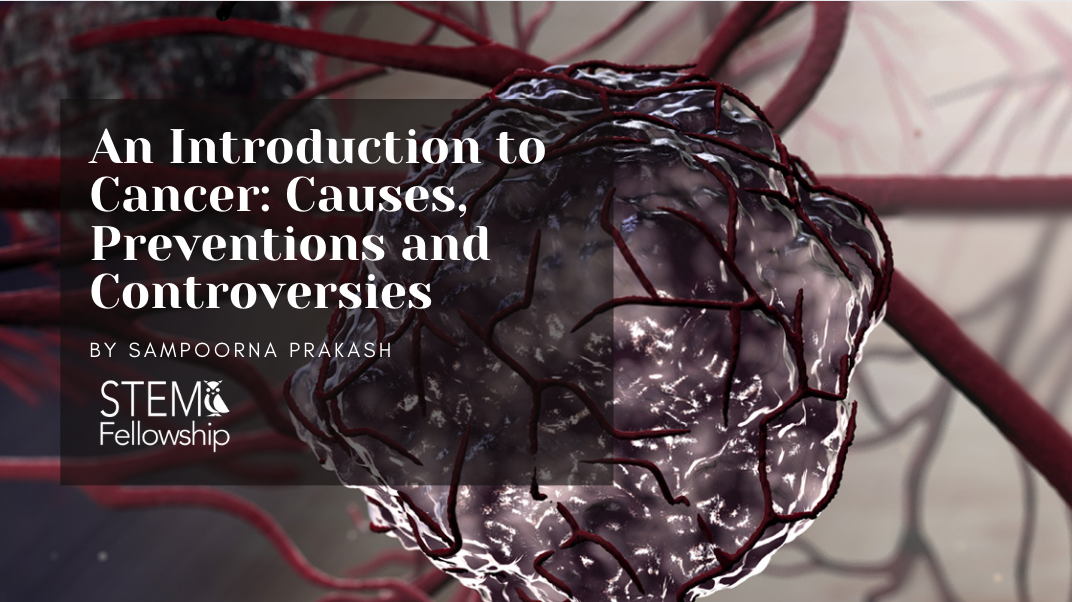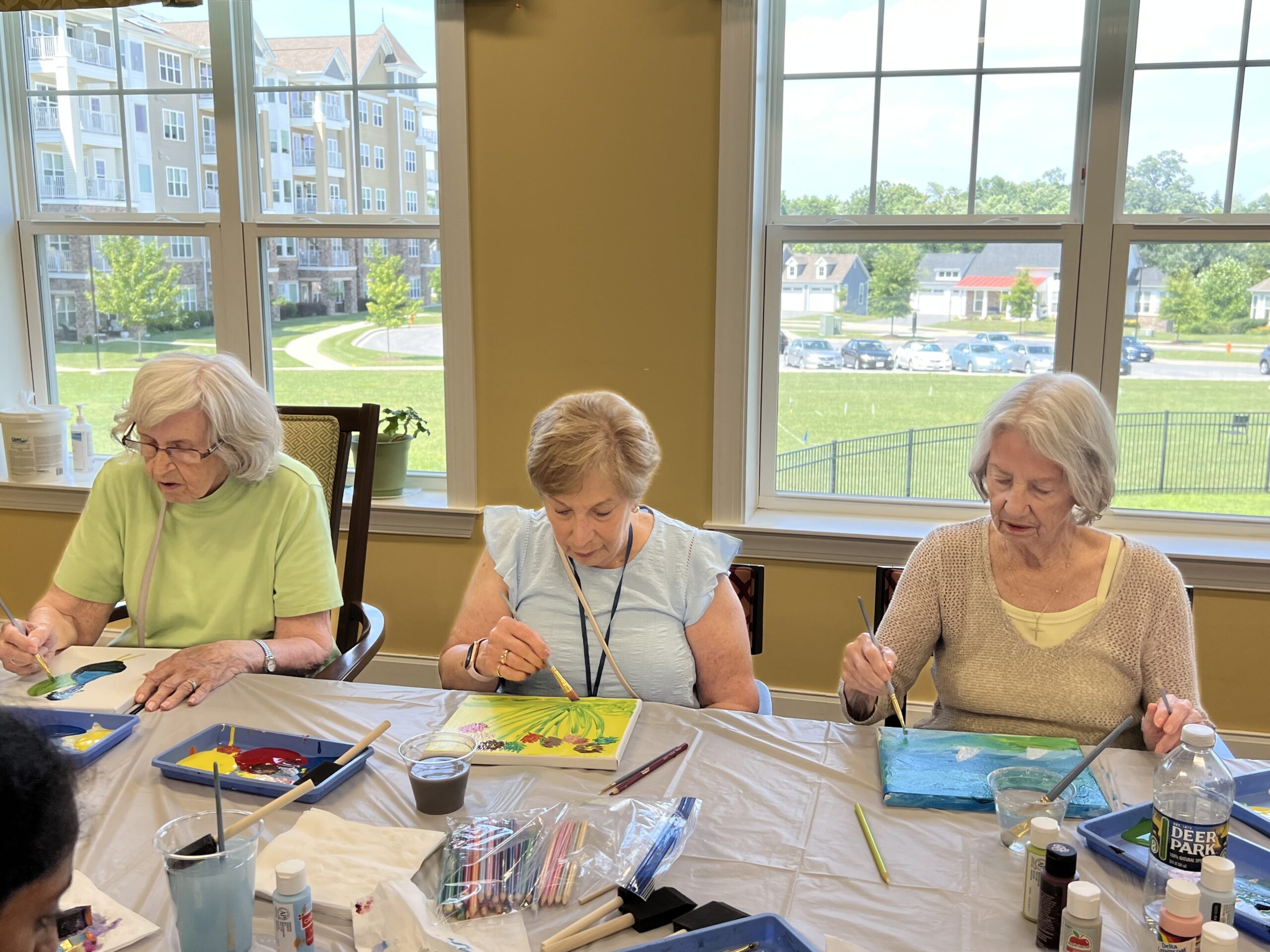By Sampoorna Prakash
Cancer is a well known, fatal disease that affects millions of people and children worldwide each year. No cure has been found to completely eradicate cancer cells even after decades of focused research!
What is Cancer?
In one line, cancer is caused when cells divide uncontrollably and spread to surrounding tissues, but it is more complicated than that. (2) There are circulating tumor cells (CTCs) or cancer stem cells (CSCs) which are responsible for all metastases and cancer deaths. (3) Metastasis is a term used by oncologists when cancer spreads in the body to other organs and tissues. (3) As these cancer cells grow uncontrollably and infiltrate other cells, they begin to form tumors which grow in solid tissues, organs, or bones. At this stage, the chances of survival are the lowest, and access to treatment becomes crucial. However, not all tumors are cancerous or malignant (invasive); they can be benign, which means they don’t invade other cells or metastasize, but instead push the normal cells to the side. (4)
Both cancer cells and tumors develop over the course of 10-12 years, and often go unnoticed by patients. (3) For example, breast cancer tumors begin to form 10 years before physiological signs appear. This unnoticeable nature of tumors makes regular checkups and exams, especially pathological examinations, crucial for tumor detection and to further prevent it from growing and spreading throughout the body. (4)
What are the causes of cancer?
There are 3 main categories of factors that cause cancer:
Environmental toxins
- Tobacco and smoking
- Tobacco and smoking
- Mercury toxicity
- Sunlight
- Electromagnetic fields
- Geopathic stress
- Food additives
- Foci infections, especially dental infections
- Immunosuppressives and other drugs
- Ionizing and nuclear radiation
- Irradiated food
- Pesticides
- Polluted water
- Sick building syndrome (SBS)
- Xenoestrogens (6)
Infections: viruses, bacteria, fungi, parasites
Infections increase the risk of cancer as some of them disrupt the signaling required to keep cell growth and proliferation in check. Some infections also weaken the immune system, increasing the risk of cancer caused by other cancer-causing infections such as,
- Human papillomavirus (HPV)
- Sepsis
- Hepatitis C (7)
Biological factors
- Poor diet and nutritional deficiency
- Chronic stress
- Depressed thyroid function
- Intestinal toxicity
- Unbalanced cellular terrain
- Hormone therapies
- Compromised detoxification
- Cellular oxygen deficiency (8)
How to prevent cancer?
1. Healthy living
Researchers have found that preventable steps can be taken to lower the risk of getting cancer. Although cancer can be hereditary, certain factors can increase one’s likelihood of developing the disease. These factors include: diet, detoxification of the body, exercise, nutritional supplements, stress management, and sleep. (9) Although there is no certain way to prevent cancer, being active, maintaining a healthy and stress-free lifestyle can reduce the risk of cancer as well as many other diseases like heart problems, mental health issues, obesity, etc.
2. Healthy eating
(10)
Since diet is a large contributor to causing cancer, many people believe that eating sugar increases the risk of developing certain types of cancer such as breast, bowel, pancreas and bladder cancers. (11) Nonetheless, recent research has shown no direct correlation between cancer development and consumption of sugary foods. It is true that eating sugar helps cancer cells grow, but it also helps normal, healthy cells grow as they require glucose to function. If too much sugar is consumed then insulin levels in the blood spike. This increases the release of insulin-like growth factor (IGF) in the body. (12) Insulin-like growth factor is a mediator of the growth hormone (GH), and a mediator of GH-independent anabolic responses in many cells and tissues. (13) Eating anything in excess is harmful to the body and can cause other diseases, not just cancer.
Eating meals rich in complex carbohydrates, healthy fat, and protein is enough to counteract the sugary foods in the body. (14) Having protein and healthy fat in breakfast gives lasting energy and reduces sugar cravings which helps in sugar detox. Foods rich in protein and fat include eggs, peanut butter, beans, legumes, protein smoothies, fatty fish, nuts, avocado, unsweetened coconut products, grass-fed butter or ghee (unless you are lactose-intolerant), and seeds. (14) Complex carbohydrates are high in fiber and digest slowly which controls sugar cravings and irregular eating habits. Foods rich in carbs include sweet potato, green leafy vegetables, pumpkin seeds, butternut squash, and beans. (14) Replacing desserts with fruits is a healthier alternative too as they increase the fiber, vitamins, minerals, and antioxidants in the body. Berries such as raspberries, blackberries, strawberries, pears, and plums are the lowest in natural sugar. (14) Keeping the body hydrated is also very important as it helps oxygen flow more easily and flushes out waste products and sugar from the body faster. (14)
Keeping these dietary choices in mind will not only reduce the chances of developing life-long diseases such as cancer, but also lead to a longer, healthier life!
3. Consuming Curcumin IV: Can it slow cancer growth?
(16)
IV therapy is intravenous therapy in which fluids, medications, and nutrients are directly injected into the patients veins.
Curcumin is a substance found in turmeric, a spice widely used in Asian countries to treat a variety of illnesses, including inflammation in the body and arthritis. Laboratories have shown that turmeric has anti-cancer effects and it can slow down the growth of certain cancers in the body. (17) People who consume between 100mg-200mg of turmeric in their daily meals have reportedly shown lower rates of developing cancer. (17) As a result of this finding, many scientists hypothesize that curcumin IV therapy along with chemotherapy can help slow down developments of tumor and cancer cells and may kill cancer cells as well. However, there hasn’t been any concrete evidence yet that supports these claims. Research regarding this therapy is still ongoing.
All in all, many more integrative and holistic therapies are being developed to treat cancer hand-in-hand with traditional therapies (chemotherapy, radiation and surgery) to increase the efficacy of treatment and eradicate more cancer cells from the body. Complementing the treatments with a healthy diet and healthy lifestyle not only decreases the chances of developing cancer again but also helps the body recover from it faster. Keeping clean surroundings and healthy relationships with others also reduces the chances of developing cancer and other life long diseases.
References:
(1) Technology Networks. [Cancer Cells Proliferating Healthy Cells][image on Internet]. 2021 [cited 2022 Apr 12]. Available from: https://www.technologynetworks.com/cancer-research/news/chemo-creates-leaky-blood-vessels-helping-cancer-cells-to-spread-355400
(2) National Cancer Institute. What Is Cancer? [Internet]. National Cancer Institute. Cancer.gov; 2021 [updated 2021 May 5; cited 2022 Apr 12]. Available from: https://www.cancer.gov/about-cancer/understanding/what-is-cancer
(3) Connealy LE. The Cancer Revolution: A Groundbreaking Program to Reverse and Prevent Cancer. Da Capo Lifelong Books; 2016. 4 p.
(4) CTCA. What’s the difference? Benign and malignant tumors [Internet]. Cancer Treatment Centers of America. Cancer Treatment Centers of America (CTCA) Comprehensive Cancer Care Network; 2017 [cited 2022 Apr 12]. Available from: https://www.cancercenter.com/community/blog/2017/12/whats-the-difference-benign-and-malignant-tumors
(5) Cancer Treatment Centers of America. Not all tumors are malignant, or cancerous, and not all are aggressive. [image on Internet]. 2017 [cited 2022 Apr 13]. Available from: https://www.cancercenter.com/community/blog/2017/12/whats-the-difference-benign-and-malignant-tumors
(6) Connealy LE. The Cancer Revolution: A Groundbreaking Program to Reverse and Prevent Cancer. Da Capo Lifelong Books; 2016. 8 p.
(7) Connealy LE. The Cancer Revolution: A Groundbreaking Program to Reverse and Prevent Cancer. Da Capo Lifelong Books; 2016. 10 p.
(8) Connealy LE. The Cancer Revolution: A Groundbreaking Program to Reverse and Prevent Cancer. Da Capo Lifelong Books; 2016. 11 p.
(9) Connealy LE. The Cancer Revolution: A Groundbreaking Program to Reverse and Prevent Cancer. Da Capo Lifelong Books; 2016. 5 p.
(10) Campbell A. Sugar: Fact or Fiction [image on Internet]. 2021 [cited 2022 Apr 20]. Available from: https://www.diabetesselfmanagement.com/healthy-living/nutrition-exercise/sugar-fact-or-fiction/
(11) Cancer Council. Does sugar cause cancer? [Internet]. Cancer.org.au. 2022 [cited 2022 Apr 19]. Available from: https://www.cancer.org.au/iheard/does-sugar-cause-cancer
(12) Burke N, Karsies D, Shannon-Hagen M. Sugar and cancer: does sugar increase cancer risk? [Internet]. Rogel Cancer Center | University of Michigan. 2016 [cited 2022 Apr 19]. Available from: https://www.rogelcancercenter.org/living-with-cancer/mind-body-side-effects/nutrition/sugar-and-cancer-does-sugar-increase-cancer-risk
(13) Clemmons DR. Physiology of insulin-like growth factor 1 [Internet]. Uptodate. 2019 [cited 2022 Apr 19]. Available from: https://www.uptodate.com/contents/physiology-of-insulin-like-growth-factor-1
(14) Elite Medical Center. 6 Ways to Remove Sugar from Your Diet [Internet]. Elite Medical Center. 2021 [cited 2022 Jun 17]. Available from: https://elitelv.com/6-ways-to-remove-sugar-from-your-diet/
(15) Giridhar K. Curcumin: Can it slow cancer growth? [Internet]. Mayo Clinic. 2022 [cited 2022 Apr 19]. Available from: https://www.mayoclinic.org/diseases-conditions/cancer/expert-answers/curcumin/faq-20057858
(16) Aum Extracts. [Turmeric Powder’s powerful benefits on the body] [image on Internet]. 2020 [cited 2022 Apr 20]. Available from: https://aumextracts.com/2020/05/03/health-benefits-of-organic-turmeric-curcumin-supplements/
(17) Cancer Research UK [Internet]. 2002. Turmeric and Cancer; 2013 [2022 Apr 19]; [5 screens]. Available from: https://www.cancerresearchuk.org/about-cancer/cancer-in-general/treatment/complementary-alternative-therapies/individual-therapies/turmeric
About The Author:
Sampoorna Prakash is a grade 11 student at Earl of March Secondary School. She is interested in medicine and computer science and is trying to find a common area in both of them to study for post-secondary school. She likes to write articles about diseases and medicines that are being developed to treat them.
Contact Sampoorna:
Email: sampoornap@gmail.com
Instagram: sampoorna2005









